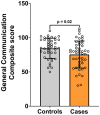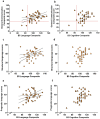Communication skills in children aged 6-8 years, without cerebral palsy cooled for neonatal hypoxic-ischemic encephalopathy
- PMID: 36272982
- PMCID: PMC9588000
- DOI: 10.1038/s41598-022-21723-1
Communication skills in children aged 6-8 years, without cerebral palsy cooled for neonatal hypoxic-ischemic encephalopathy
Abstract
We assessed communication skills of 48 children without cerebral palsy (CP) treated with therapeutic hypothermia (TH) for neonatal hypoxic-ischemic encephalopathy (HIE) (cases) compared to 42 controls at early school-age and examined their association with white matter diffusion properties in both groups and 18-month Bayley-III developmental assessments in cases. Parents completed a Children's Communication Checklist (CCC-2) yielding a General Communication Composite (GCC), structural and pragmatic language scores and autistic-type behavior score. GCC ≤ 54 and thresholds of structural and pragmatic language score differences defined language impairment. Using tract-based spatial statistics (TBSS), fractional anisotropy (FA) was compared between 31 cases and 35 controls. Compared to controls, cases had lower GCC (p = 0.02), structural (p = 0.03) and pragmatic language score (p = 0.04) and higher language impairments (p = 0.03). GCC correlated with FA in the mid-body of the corpus callosum, the cingulum and the superior longitudinal fasciculus (p < 0.05) in cases. Bayley-III Language Composite correlated with GCC (r = 0.34, p = 0.017), structural (r = 0.34, p = 0.02) and pragmatic (r = 0.32, p = 0.03) language scores and autistic-type behaviors (r = 0.36, p = 0.01).
© 2022. The Author(s).
Conflict of interest statement
The authors declare no competing interests.
Figures






References
-
- Jacobs, S. E., Berg, M., Hunt, R., Tarnow‐Mordi, W.O., Inder, T.E., & Davis, P.G. Cooling for newborns with hypoxic ischaemic encephalopathy. Cochrane Database Syst. Rev. (2013). - PubMed
-
- Lee-Kelland R, Jary S, Tonks J, Cowan FM, Thoresen M, Chakkarapani E. School-age outcomes of children without cerebral palsy cooled for neonatal hypoxic–ischaemic encephalopathy in 2008–2010. Arch. Dis. Child. Fetal Neonatal Ed. 2020;105(1):8–13. doi: 10.1136/archdischild-2018-316509. - DOI - PubMed
Publication types
MeSH terms
Grants and funding
LinkOut - more resources
Full Text Sources
Medical
Miscellaneous

